
The Lockheed MC-130 is the basic designation for a family of special mission aircraft operated by the United States Air Force Special Operations Command (AFSOC), a wing of the Air Education and Training Command, and an AFSOC-gained wing of the Air Force Reserve Command. Based on the Lockheed C-130 Hercules transport, the MC-130s' missions are the infiltration, exfiltration, and resupply of special operations forces, and the air refueling of (primarily) special operations helicopter and tilt-rotor aircraft.

Air Force Special Operations Command (AFSOC), headquartered at Hurlburt Field, Florida, is the special operations component of the United States Air Force. An Air Force major command (MAJCOM), AFSOC is also the U.S. Air Force component command to United States Special Operations Command (USSOCOM), a unified combatant command located at MacDill Air Force Base, Florida. AFSOC provides all Air Force Special Operations Forces (SOF) for worldwide deployment and assignment to regional unified combatant commands.

Kadena Air Base is a United States Air Force base in the towns of Kadena and Chatan and the city of Okinawa, in Okinawa Prefecture, Japan. It is often referred to as the "Keystone of the Pacific" because of its highly strategic location. It is located 650 km (400 mi) off the coast of China and at a distance of 770 km (480 mi) from Shanghai, a major economic hub. It is home to the USAF's 18th Wing, the 353rd Special Operations Wing, reconnaissance units, 1st Battalion, 1st Air Defense Artillery Regiment, and a variety of associated units. Over 20,000 American servicemembers, family members, and Japanese employees live or work at Kadena Air Base. It is the largest and most active U.S. Air Force base in East Asia.

The 27th Special Operations Wing, also known as "The Steadfast Line", is a wing of the United States Air Force stationed at Cannon Air Force Base, New Mexico. It is assigned to the Air Force Special Operations Command (AFSOC).
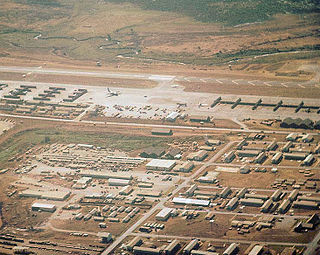
Pleiku Air Base is a former air force base in Vietnam. It was established by the Republic of Vietnam Air Force (RVNAF) in 1962 at an undeveloped airstrip, and was used by the United States Air Force during the Vietnam War in the II Corps Tactical Zone of South Vietnam. It was captured by the People's Army of Vietnam (PAVN) in March 1975 and was abandoned for many years. Today, the facility has just redeveloped as Pleiku Airport。
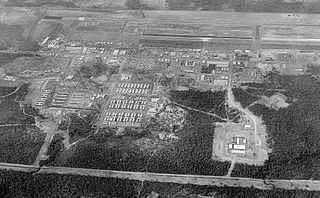
The Nakhon Phanom Royal Thai Navy Base (NKP), formerly Nakhon Phanom Royal Thai Air Force Base, is a Royal Thai Navy facility used for riverine patrols along the Mekong River. It is approximately 587 km (365 mi) northeast of Bangkok, 14.5 km (9.0 mi) west of Nakhon Phanom city in Nakhon Phanom Province in the northeastern region of Thailand, and 411 km (255 mi) from Hanoi in Vietnam. The Mekong River is NKP's border with Laos. The airfield at NKP is jointly used as a civilian airport.

The 353rd Special Operations Wing is an operational unit of the United States Air Force Special Operations Command, stationed at Kadena Air Base, Japan.

The 7th Special Operations Squadron is an active flying unit of the United States Air Force. It is a component of the 752d Special Operations Group, United States Special Operations Command, and is currently based at Royal Air Force Station Mildenhall in Suffolk, UK. From their base at RAF Mildenhall, the 7th Special Operations Squadron is able to deploy or extract troops from hostile, sensitive, or otherwise undesirable locations.
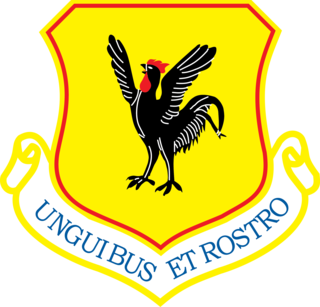
The United States Air Force's 18th Wing is the host wing for Kadena Air Base, Okinawa, Japan and is the Air Force's largest combat wing. It is the largest and principal organization in the Pacific Air Forces Fifth Air Force.

The 319th Special Operations Squadron was first activated in September 1944 as the 319th Troop Carrier Squadron (Commando) and served in the China-Burma-India Theater during World War II. It provided airlift support and conducted airborne drops and glider operations for Allied troops in Burma, central China, and French Indochina in the last year of World War II.

The 1st Special Operations Wing at Hurlburt Field, Florida is one of three United States Air Force active duty Special Operations wings and falls under the Air Force Special Operations Command (AFSOC).

The Commandant of Cadets is a named organization of the United States Air Force based at the Air Force Academy in Colorado Springs, Colorado. Until August 2006 the commander of the 34th Training Wing was "dual-hatted" as the Commandant of Cadets at the Academy. In that month the 34th Wing became a named organization.

The 919th Special Operations Wing is an Air Reserve Component (ARC) unit of the United States Air Force. The 919 SOW is assigned to the Tenth Air Force of the Air Force Reserve Command (AFRC) and is stationed at Duke Field, Florida.

The 6th Special Operations Squadron is part of the 27th Special Operations Wing at Cannon Air Force Base, New Mexico. The squadron operates MC-130J Commando II aircraft in support of special operations. The 6th SOS specializes in the use of night vision goggles and formation tactics to refuel large helicopter and tilt-rotor formations.

The 9th Special Operations Squadron is part of the 27th Special Operations Wing at Cannon Air Force Base, New Mexico. The squadron operates MC-130J Commando II aircraft in support of special operations. The 9th SOS specializes in the use of night vision goggles and formation tactics to refuel large helicopter and tilt-rotor formations. On 9 December 2014, the 522nd SOS was re-flagged as the 9th SOS moved from its location at Hurlburt Field to join the 27 SOW at Cannon Air Force Base.
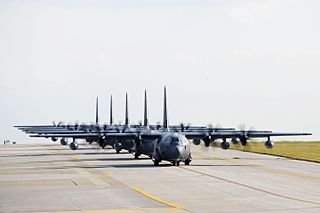
The 17th Special Operations Squadron is an active unit of the United States Air Force, stationed at Cannon Air Force Base, New Mexico. The squadron operates AC-130J Ghostrider aircraft and is assigned to the 27th Special Operations Group, 27th Special Operations Wing. The squadron was previously part of the 353rd Special Operations Group at Kadena Air Base, Japan, where it operated MC-130J Commando II aircraft providing special operations capability.
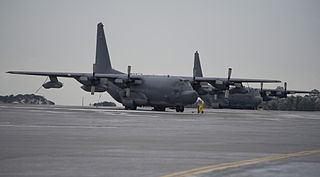
The 19th Special Operations Squadron is an Air Force Special Operations Command unit, part of the 492nd Special Operations Wing at Hurlburt Field, Florida. It conducts crew training for AC-130 and Lockheed MC-130 aircraft.

The 602nd Special Operations Squadron was a United States Air Force squadron that operated in Southeast Asia during the Vietnam War.

The 604th Special Operations Squadron is an inactive United States Air Force squadron It was last active at Bien Hoa Air Base, Vietnam, where it was inactivated in September 1970.

The 56th Fighter Wing is a fighter wing in the United States Air Force. It is the world's largest Lockheed Martin F-35 Lightning II wing and one of two Air Force F-35 training locations. Additionally, it is one of two active-duty F-16 training bases. The 56th graduates dozens of F-35 and General Dynamics F-16 Fighting Falcon pilots and 300 air control professionals annually.

























